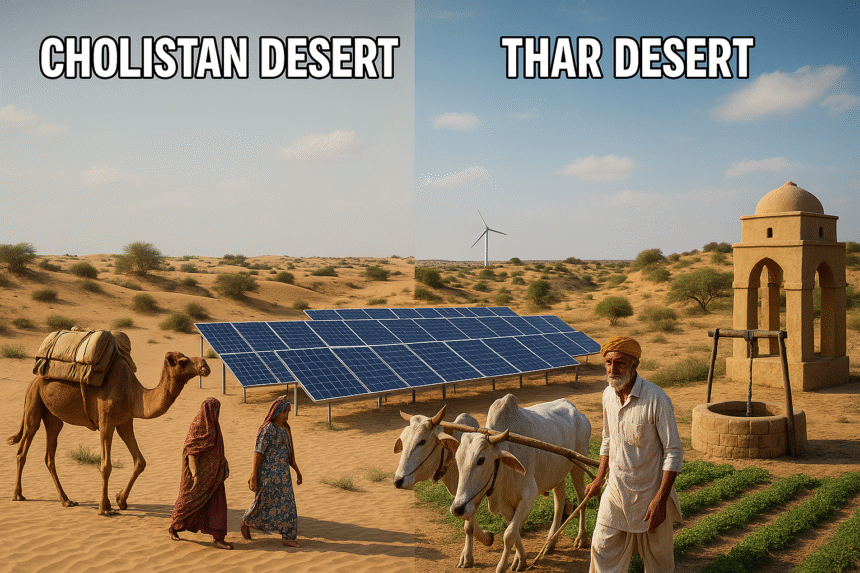By ALLAH BAKHSH GULSHAN
GHAZI UNIVERSITY DERA GHAZI KHAN
Cholistan and Thar historical desert consist of millions of populaces in the southern region of Pakistan. The challenges and issues of both hot regions are common and population of the area face these challenges in hard condition from many years to till now. In the recent technology era, the challenges need to be addressed at the government level to ease the livelihood of populace of the regions. No doubt the recent federal and provincial governments are focusing on these hard and remote regions/ areas to uplift the life of human population and try to save the natural diversity of wild life. The public sector organizations are trying for availability of water and other resources to the door step of populace of the Cholistan and Thar regions, which are the basic necessities for the agricultural practices and living needs of people. Moreover, both the regions have unique cultural traditions and environment. The habitat is characterized by harsh surroundings, inadequate resources and difficult lifestyle.
Notwithstanding these challenges, the brave and hard worker type people of Cholistan and Thar desert have developed resilient livelihood strategies that enable them to survive and thrive in these hard environments. However, the livelihoods of people in these deserts are facing numerous challenges, and the most significant ones include water shortage, limited access to education and basic healthcare facilities, poverty, and fluctuating climatic factor of the area. Solar and wind power are the renewable energy sources that has significant potential for the energy in both desert areas. Eco-tourism and sustainable livelihoods are dual features in nature and beauty of the area. These are the exclusive cultural traditions and natural resources of Cholistan and Thar regions. A comparative picture of livelihoods in Cholistan and Thar desert reveals that first one has a more developed infrastructure and a stronger tradition of livestock production, while Thar desert has a more diverse economy and a stronger tradition of agriculture respectively.
Understanding these differences is crucial for developing effective sustainable development strategies that are custom-made to the specific needs and contexts of each region. By promoting sustainable development in Cholistan and Thar Desert regions, we could improve the livelihoods of millions of people, reduce poverty, and promote economic growth. The Cholistan and Thar Desert regions of Pakistan are home to millions of people who face significant challenges in their daily lives. Despite their unique cultural and historical contexts, both regions share commonalities in terms of their geographical characteristics, economic conditions, and social structures. A comprehensive analysis of livelihoods in Cholistan and Thar Desert regions, highlighting the challenges, opportunities, and sustainable development strategies that can improve the lives of inhabitants. The clear picture of geographical characteristics of both the regions show similarity in environment, but culture is somehow variable. The Cholistan desert is started from the south-eastern part of division of Bahawalpur in Punjab, Pakistan and 26,000 square kilometers an area is covered under the terrain of desert approximately. The region is characterized into subtropical consist of undulating sandy dunes, arid climate, and limited wild vegetation.
In other side the Thar desert is located in the southeastern part of Sindh province, Pakistan and approximately 140,000 square kilometers area is covered under the topography of Thar range. The landscape is also covered by sandy dunes, arid climate, and spreaded patches of wild vegetation. The linkage between the Livelihoods in Cholistan and Thar desert regions is view that the livelihoods of inhabitants in Cholistan and Thar deserts are primarily based on agriculture, livestock rearing, and non-farm activities. Agriculture is the mainstay of the economy in both regions, with crops such as wheat, cotton, and sugarcane being grown in Cholistan, and wheat, cotton, and mangoes being grown in Thar. Livestock rearing is also an important activity in both regions, with animals such as goats, sheep, and cattle being raised for meat, milk, and wool. There are many challenges face the inhabitants of Cholistan as well as the thar desert.
The population of each area has although a significant challenges in the daily lives of inhabitants, which include first and vital thing, which is a common in both the populace of the regions i.e they face the severe shortage of water that directly effects on agriculture, livestock, and human use. Second one is the education and healthcare facilities, which are limited in both regions. Thirdly, poverty level among the community is spread below the poverty line. Fourthly, climate change is a major challenge of the areas because due to rising temperature, changing rainfall patterns, and increased frequency of natural disasters are very common. The exclusive cultural and natural heritage of both regions can be leveraged to promote eco-tourism, which can generate income and create jobs for the local community.
The value chain development can help improve the livelihoods of inhabitants by increasing the value of agricultural and livestock products. The community-based initiatives can help promote sustainable development and improve the lives of inhabitants. There are many strategies for the development of such kind of deserts like Cholistan and Thar to improve the livelihoods of inhabitants of the regions. Few sustainable development strategies can be implemented that are: 1. Implementing water conservation measures, such as rainwater harvesting and efficient irrigation systems, can help improve water availability. 2. Promoting renewable energy, such as solar and wind power, can help reduce dependence on fossil fuels and mitigate climate change.3. Promoting sustainable agriculture practices, such as crop rotation and organic farming, can help improve soil health and reduce environmental degradation. 4. Supporting community-based initiatives, such as community-managed forests and wildlife conservation, can help promote sustainable development and improve livelihoods.
Finally, it is concluded that living standard of inhabitants of Cholistan and Thar deserts of Pakistan are categorized into various substantial challenges in which water shortage, lack of infra-structure of education and basic healthcare centers, poverty below poverty level of the community and factor of climate change. In contrast, some opportunities like sustainable development which are including renewable energy, eco-tourism, value chain development, and community-based initiatives in the areas. These good indicators, the government of Pakistan are continuously increased his attention to maintain upto the mark sustainability practices for the welfare of the community of the both regions. In addition, government is also trying to Implement the sustainable development strategies, such as water conservation, renewable energy, sustainable agriculture, and community-based initiatives, which could help and improve the livelihoods of inhabitants of Cholistan and thar deserts.
By adopting a comprehensive approach to address such types of challenges and maintain the upright opportunities that change and improve the livelihoods of millions of people in the area. Finally, there are few recommendations for the public sector organization and private strong companies for addressing the challenges in a better way to improve the life of both the regions. First and most important one is the increase of investment conservation of water strategies such as rainwater, which are used in cultivation and harvesting mechanism of the crops due to efficient irrigation systems. Second one to promote and invest in the field of renewable energy, such as solar and wind power, to reduce dependence on fossil fuels and mitigate climate change. Third and progressive part of recommendation is to support sustainable agriculture practices, such as crop rotation and organic farming, to improve soil health and reduce environmental degradation. Last one is to adopt the encouraging approach to the community-based initiatives, such as community-managed forests and wildlife conservation, to promote sustainable development and improve livelihoods. Then by implementing these recommendations, the livelihoods of inhabitants in Cholistan and Thar Desert regions can be improved, and sustainable development can be promoted in both regions.
PAKISTAN PAINDA BAD






